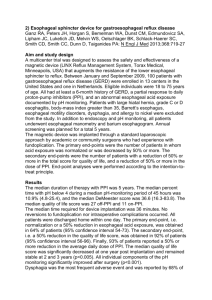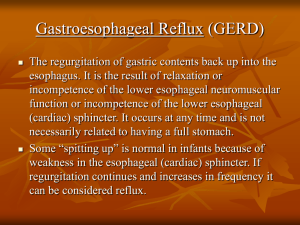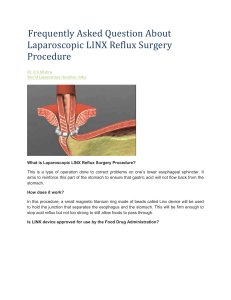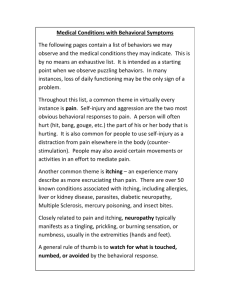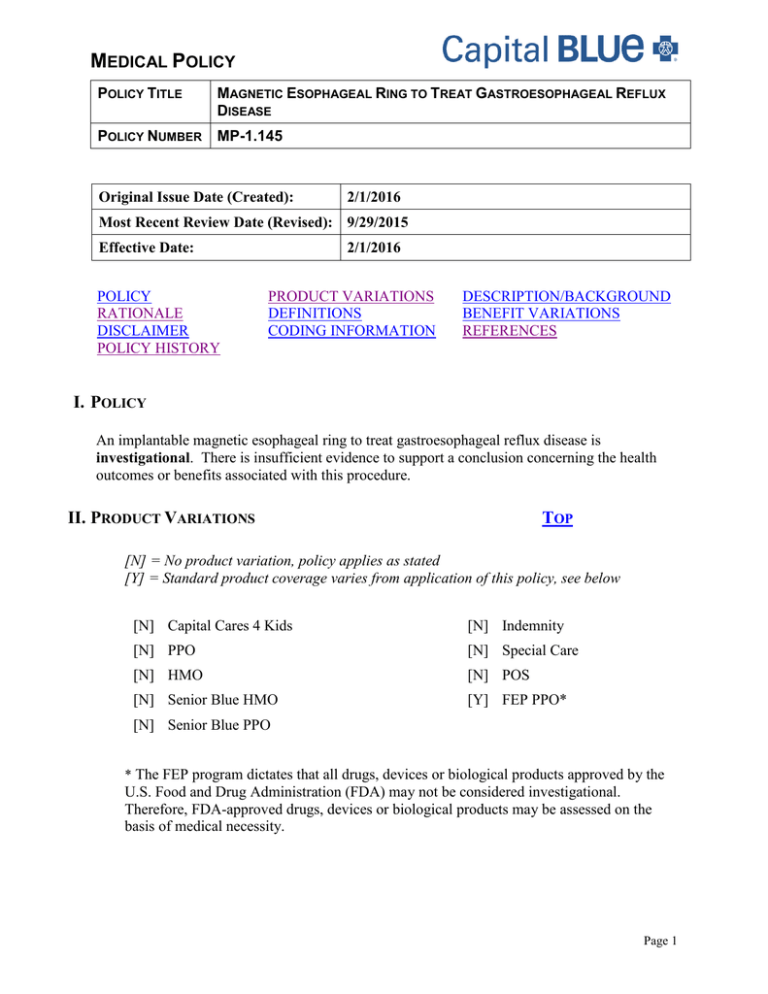
MEDICAL POLICY
POLICY TITLE
MAGNETIC ESOPHAGEAL RING TO TREAT GASTROESOPHAGEAL REFLUX
DISEASE
POLICY NUMBER
MP-1.145
Original Issue Date (Created):
2/1/2016
Most Recent Review Date (Revised): 9/29/2015
Effective Date:
POLICY
RATIONALE
DISCLAIMER
POLICY HISTORY
2/1/2016
PRODUCT VARIATIONS
DEFINITIONS
CODING INFORMATION
DESCRIPTION/BACKGROUND
BENEFIT VARIATIONS
REFERENCES
I. POLICY
An implantable magnetic esophageal ring to treat gastroesophageal reflux disease is
investigational. There is insufficient evidence to support a conclusion concerning the health
outcomes or benefits associated with this procedure.
II. PRODUCT VARIATIONS
TOP
[N] = No product variation, policy applies as stated
[Y] = Standard product coverage varies from application of this policy, see below
[N] Capital Cares 4 Kids
[N] Indemnity
[N] PPO
[N] Special Care
[N] HMO
[N] POS
[N] Senior Blue HMO
[Y] FEP PPO*
[N] Senior Blue PPO
* The FEP program dictates that all drugs, devices or biological products approved by the
U.S. Food and Drug Administration (FDA) may not be considered investigational.
Therefore, FDA-approved drugs, devices or biological products may be assessed on the
basis of medical necessity.
Page 1
MEDICAL POLICY
POLICY TITLE
MAGNETIC ESOPHAGEAL RING TO TREAT GASTROESOPHAGEAL REFLUX
DISEASE
POLICY NUMBER
MP-1.145
III. DESCRIPTION/BACKGROUND
TOP
GERD is defined as reflux of stomach acid into the esophagus that causes symptoms and/or
mucosal injury. GERD is a common medical disorder, with estimates of 10% to 20% prevalence
in developed countries. The severity of GERD is widely variable. Many patients have mild,
intermittent symptoms that do not require treatment or only require episodic use of medications.
Other patients have chronic, severe GERD that can lead to complications such as Barrett
esophagus and esophageal cancer. For patients with severe disease, chronic treatment with acid
blockers is one option. For some patients, medications are not adequate to control symptoms, and
other patients prefer to avoid the use of indefinite, possibly lifelong medications. Surgical
treatments are available for these patients, primarily a Nissen fundoplication performed either
laparoscopically or by open surgery. A number of less invasive procedures are also being
evaluated as an intermediate option between medical therapy and surgery.
The LINX™ Reflux Management System (Torax Medical) is composed of a small flexible band
of 10 to 18 interlinked titanium beads with magnetic cores. Using standard laparoscopic
techniques, the band is placed around the esophagus at the level of the gastroesophageal junction.
The magnetic attraction between the beads is intended to augment the lower esophageal
sphincter to prevent gastric reflux into the esophagus, without compressing the esophageal wall.
It is proposed that swallowing food or liquids creates sufficient pressure to overcome the
magnetic bond between the beads, allowing the beads to separate and temporarily increase the
size of the ring. The target population is patients who have GERD symptoms despite maximum
medical therapy (e.g., proton pump inhibitors) but who do not want to risk the adverse effects of
a surgical procedure like Nissen fundoplication. Adverse events of the LINX™ Reflux
Management System may include dysphagia or odynophagia. The device can be removed by a
laparoscopic procedure if severe adverse events occur or if magnetic resonance imaging is
needed for another condition.
Regulatory Status
The LINX™ Reflux Management System was approved by FDA in 2012. The LINX™ device is
indicated for patients diagnosed with GERD, as defined by abnormal pH testing, and who
continue to have chronic GERD symptoms despite maximum therapy for the treatment of reflux.
FDA has required 5-year follow-up of 100 patients from the investigational device exemption
pivotal study to evaluate safety and efficacy of the device. FDA product code: LEI.
Page 2
MEDICAL POLICY
POLICY TITLE
MAGNETIC ESOPHAGEAL RING TO TREAT GASTROESOPHAGEAL REFLUX
DISEASE
POLICY NUMBER
MP-1.145
IV. RATIONALE
TOP
The most recent literature update was performed through July 15, 2014.
Randomized controlled trials are necessary to establish the efficacy of treatments for
gastroesophageal reflux disease (GERD). GERD has a variable natural history, with
exacerbations and remissions, and, as a result, a control group is required to differentiate
improvements in symptoms from the natural history of the disorder. A placebo control is optimal
due to the subjective nature of the patient-reported outcome measures, which are prone to bias if
the patient is not blinded to treatment assignment. Random assignment is important because of
the multiple potential confounders of GERD outcomes, such as diet, smoking, and obesity.
Randomization minimizes the chance that these confounders will be distributed unequally among
treatment groups.
Single-arm series are of limited usefulness for determining treatment efficacy. Improvements in
symptoms in single-arm studies may be due to the variable natural history of GERD, and/or bias
from the placebo and other nonspecific effects. Single-arm series can demonstrate the feasibility
and potential benefit of this procedure and can be used to determine rates of adverse events. It is
also important to determine comparative efficacy of treatments for GERD, because there are
numerous medical and surgical treatments that are effective. Single-arm series are inadequate for
determining comparative effectiveness of different treatment options; controlled trials with active
comparators are required for this.
Food and Drug Administration‒Regulated Trials
Data submitted to the U.S. Food and Drug Administration (FDA) for the LINX® Reflux
Management System included 2 single-arm FDA-regulated investigational device exemption
(IDE) trials with a total of 144 subjects and follow-up data between 2 and 4 years.1 The
feasibility IDE study enrolled 44 subjects at 4 clinical sites (2 U.S., 2 Europe) and has published
data out to 4 years.2,3 The pivotal IDE study included 100 subjects from 14 clinical sites (13
U.S., 1 Europe) who had documented symptoms of GERD for more than 6 months (regurgitation
or heartburn that responds to acid neutralization or suppression), required daily proton pump
inhibitor (PPI) or other antireflux drug therapy, had symptomatic improvement on PPI therapy,
and had a total distal ambulatory esophageal pH less than 4 for 4.5% or more of the time when
off GERD medications. The primary safety end point measured the rate of related device and
procedure serious adverse events (SAEs). Efficacy end points were assessed off PPI therapy and
measured esophageal acid exposure, total Gastroesophageal Reflux Disease-Health Related
Quality of Life (GERDHRQL) scores, and PPI usage. Subjects served as their own controls.
Results of the pivotal trial were published in 2013.4 In this study, the primary efficacy end point
of pH normalization or greater than 50% reduction in acid exposure time when off PPI was met
by 64% of the subjects. The mean total acid exposure time was reduced from 11.6% at baseline
Page 3
MEDICAL POLICY
POLICY TITLE
MAGNETIC ESOPHAGEAL RING TO TREAT GASTROESOPHAGEAL REFLUX
DISEASE
POLICY NUMBER
MP-1.145
to 5.1% at 12 months (56% reduction). The secondary efficacy end points met the study success
criteria. Ninety-two percent of subjects had at least a 50% improvement in GERD-HRQL
symptom score (the mean GERD-HRQL total score decreased from 28.4 at baseline to 5.9 and
5.5 at 12 and 24 months, respectively), and 93% had reduced PPI use (79% and 83% of subjects
were free from daily dependence at 12 and 24 months, respectively, compared with 0% at
baseline). Dysphagia was observed in 68% of patients postoperatively, in 11% at 1 year, and in
4% at 3 years. Nineteen patients underwent esophageal dilation for dysphagia. Six patients (6%)
experienced an SAE including severe dysphagia and vomiting. The device was removed in 4 of
these 6 patients with an SAE and in 2 additional patients for persistent reflux and chest pain.
Nonrandomized Controlled Trials
Two retrospective comparative studies have been identified on magnetic sphincter augmentation
(MSA) with the LINX® device compared with laparoscopic Nissen fundoplication (LNF). Louie
at al compared outcomes from 34 patients who had MSA with 32 patients who underwent LNF.5
similar improvements were found for the 2 groups on the GERD-HRQL scale. The DeMeester
score and pH normalized in both groups, but these were lower (p=0.001) in the fundoplication
group. MSA allowed belching in 67% of patients compared with none in the fundoplication
group. Sheu et al compared outcomes from 12 MSA patients with a contemporaneous casematched cohort of patients who underwent LNF.6 Over half of the MSA patients were selfreferred, compared with none of the patients who underwent LNF. Both procedures were
effective for reflux. Severe dysphagia requiring endoscopic dilation was more frequent
after MSA (50% of cases), while there was a trend for a reduction in bloating, flatulence, and
diarrhea in this small retrospective study.
Observational Studies
In 2014, Lipham et al reported on adverse events for the first 1048 implanted patients (82
institutions).7 Of these, 144 were implanted as part of premarket clinical trials (described above),
332 had been enrolled in a postmarket registry, and 572 were implanted outside of a postmarket
registry. The 3 sources that were used to identify adverse events were the published clinical
literature along with the device’s Summary of Safety Effectiveness Data, the FDA database for
device-related complications (MAUDE database), and information provided by the
manufacturer. Event rates were 0.1% intra-/perioperative complications, 1.3% hospital
readmissions, 5.6% endoscopic dilations, and 3.4% reoperations for device removal. The primary
reason for device removal was dysphagia. Erosion of the device occurred in 1 patient (0.1%).
The median device implantation was 274 days. This study is limited by the short follow-up and
the voluntary reporting of adverse events outside of the registry.
Ongoing and Unpublished Clinical Trials
An online search of www.ClinicalTrials.gov in July 2014 identified industry-sponsored
observational studies of the LINX® Reflux Management System.
Page 4
MEDICAL POLICY
POLICY TITLE
MAGNETIC ESOPHAGEAL RING TO TREAT GASTROESOPHAGEAL REFLUX
DISEASE
POLICY NUMBER
MP-1.145
NCT01940185 is a prospective, multicenter, single-arm post approval study to monitor
the safety and efficacy of the LINX® implant procedure and device with follow-up
through 5 years. The study has an estimated enrollment of 200 patients, with completion
NCT01624506 is a registry to track and monitor patients treated with either the LINX®
device or fundoplication in clinical practice. It began in 2010, and has an estimated
enrollment of 800 patients, with completion anticipated in 2016.
Summary of Evidence
A laparoscopically implanted ring composed of interlinked titanium beads with magnetic cores
has been developed for the treatment of gastroesophageal reflux disease (GERD). The device is
placed around the esophagus at the level of the gastroesophageal junction and is being evaluated
in patients who have GERD symptoms despite maximum medical therapy. Current evidence on
magnetic sphincter augmentation (MSA) consists of 2 retrospective comparative cohort studies
along with several case series, including 2 uncontrolled and unblinded manufacturer-sponsored
studies that were submitted to the Food and Drug Administration (FDA) for device approval.
The single-arm series are of limited usefulness for determining treatment efficacy and provide no
information on the comparative efficacy of this procedure with other GERD treatments. The
comparative trials are retrospective and nonrandomized, and may be affected by selection bias.
In addition, the subjective outcome measures used in these trials, such as the Gastroesophageal
Reflux Disease-Health Related Quality of Life (GERD-HRQL) scores, may be biased due to
placebo effects in these nonblinded trials. The objective measure of esophageal pH shows
modest improvement compared with baseline, but this is a physiologic measure with uncertain
clinical significance. Dysphagia was common in treated patients, although serious adverse events
were less common, and the smaller feasibility study did not identify any serious safety concerns
at up to 4 years of follow-up. FDA has required 5 years of follow-up on the 100 subjects in the
pivotal study. Randomized comparisons of MSA with Nissen fundoplication are also needed to
evaluate the relative risk-benefit of these 2 procedures. The evidence at this time is insufficient to
permit conclusions concerning the effect of this device on net health outcome. It is considered
investigational.
Practice Guidelines and Position Statements
In 2013, the Society of American Gastrointestinal and Endoscopic Surgeons (SAGES) published
a Technology and Value Assessment guideline on the safety and effectiveness of the LINX
Reflux Management System.8 SAGES Technology and Value Assessment Committee stated that
safety analyses of the LINX system suggests the procedure is associated with few serious
adverse events and no reported mortality, and that currently available data demonstrates a
reasonable assurance as to the efficacy of the LINX Reflux Management System. The committee
concluded that direct comparative studies between the LINX procedure and Nissen
fundoplication will be needed, although based on the available evidence the LINX device should
be an option available to patients and providers for the management of medically refractory
GERD.
Page 5
MEDICAL POLICY
POLICY TITLE
MAGNETIC ESOPHAGEAL RING TO TREAT GASTROESOPHAGEAL REFLUX
DISEASE
POLICY NUMBER
MP-1.145
A 2013 report on emerging technology from the American Society for Gastrointestinal
Endoscopy concluded that long-term data about the safety and efficacy of the LINX device are
needed.9 The document indicates that the LINX band is currently being deployed
laparoscopically; however, a natural orifice transluminal endoscopic surgery approach could be
explored.
U.S. Preventive Services Task Force Recommendations
Use of magnetic esophageal rings is not a preventive service.
Medicare National Coverage
There is no national coverage determination (NCD).
V. DEFINITIONS
TOP
N/A
VI. BENEFIT VARIATIONS
TOP
The existence of this medical policy does not mean that this service is a covered benefit
under the member's contract. Benefit determinations should be based in all cases on the
applicable contract language. Medical policies do not constitute a description of benefits.
A member’s individual or group customer benefits govern which services are covered,
which are excluded, and which are subject to benefit limits and which require
preauthorization. Members and providers should consult the member’s benefit information
or contact Capital for benefit information.
VII. DISCLAIMER
TOP
Capital’s medical policies are developed to assist in administering a member’s benefits, do not constitute
medical advice and are subject to change. Treating providers are solely responsible for medical advice and
treatment of members. Members should discuss any medical policy related to their coverage or condition
with their provider and consult their benefit information to determine if the service is covered. If there is a
discrepancy between this medical policy and a member’s benefit information, the benefit information will
govern. Capital considers the information contained in this medical policy to be proprietary and it may only
be disseminated as permitted by law.
Page 6
MEDICAL POLICY
POLICY TITLE
MAGNETIC ESOPHAGEAL RING TO TREAT GASTROESOPHAGEAL REFLUX
DISEASE
POLICY NUMBER
MP-1.145
VIII. CODING INFORMATION
TOP
Note: This list of codes may not be all-inclusive, and codes are subject to change at any time. The
identification of a code in this section does not denote coverage as coverage is determined
by the terms of member benefit information. In addition, not all covered services are
eligible for separate reimbursement.
Investigational; therefore not covered:
CPT Codes®
0393T
0392T
Current Procedural Terminology (CPT) copyrighted by American Medical Association. All Rights Reserved.
IX. REFERENCES
TOP
1. U.S. Food and Drug Administration. Gastroenterology and Urology Devices Panel of
the Medical Devices Advisory Committee. LINX™ Reflux Management System. . 2012;
http://www.fda.gov/downloads/AdvisoryCommittees/CommitteesMeetingMaterials/Med
icalDevices/MedicalDevicesAdvisoryCommittee/GastroenterologyUrologyDevicesPanel/UCM286236.pdf. Accessed June, 2014.
2. Bonavina L, DeMeester T, Fockens P, et al. Laparoscopic sphincter augmentation
device eliminates reflux symptoms and normalizes esophageal acid exposure: one- and
2-year results of a feasibility trial. Ann Surg. Nov 2010;252(5):857-862. PMID
21037442
3. Lipham JC, DeMeester TR, Ganz RA, et al. The LINX(R) reflux management system:
confirmed safety and efficacy now at 4 years. Surg Endosc. Oct 2012;26(10):29442949. PMID 22538694
4. Ganz RA, Peters JH, Horgan S, et al. Esophageal sphincter device for gastroesophageal
reflux disease. N Engl J Med. Feb 21 2013;368(8):719-727. PMID 23425164
5. Louie BE, Farivar AS, Shultz D, et al. Short-Term Outcomes Using Magnetic Sphincter
Augmentation Versus Nissen Fundoplication for Medically Resistant Gastroesophageal
Reflux Disease. Ann Thorac Surg. Jun 21 2014. PMID 24961840
6. Sheu EG, Nau P, Nath B, et al. A comparative trial of laparoscopic magnetic sphincter
augmentation and Nissen fundoplication. Surg Endosc. Jul 11 2014. PMID 25012804
7. Lipham JC, Taiganides PA, Louie BE, et al. Safety analysis of first 1000 patients treated
with magnetic sphincter augmentation for gastroesophageal reflux disease. Dis
Esophagus. Mar 11 2014. PMID 24612509
8. Society of American Gastrointestinal and Endoscopic Surgeons (SAGES). TAVAC Safety
and Effectiveness Analysis: LINX® Reflux Management System. 2013;
Page 7
MEDICAL POLICY
POLICY TITLE
MAGNETIC ESOPHAGEAL RING TO TREAT GASTROESOPHAGEAL REFLUX
DISEASE
POLICY NUMBER
MP-1.145
http://www.sages.org/publications/guidelines/tavac-safetyand-effectiveness-analysislinx-reflux-management-system/. Accessed June, 2014.
9. Asge Technology Committee. Magnets in the GI tract. Gastrointest Endosc. Oct
2013;78(4):561-567. PMID 24054738
Other Sources
Novitas Solutions. Local Coverage Determination (LCD) L35094 Services That are Not
Reasonable and Necessary. Effective 10/1/15. [Website]:
https://www.novitas-solutions.com/policy/mac-ab/l31481-r1.html Accessed October 9, 2015.
X. POLICY HISTORY
MP-1.145
TOP
CAC 9/29/15 New policy. BCBSA adopted. An implantable magnetic
esophageal ring to treat gastroesophageal reflux disease is considered
investigational. FEP variation added. No Medicare variation. Coding added.
Top
Health care benefit programs issued or administered by Capital BlueCross and/or its subsidiaries, Capital Advantage Insurance
Company®, Capital Advantage Assurance Company® and Keystone Health Plan® Central. Independent licensees of the
BlueCross BlueShield Association. Communications issued by Capital BlueCross in its capacity as administrator of programs
and provider relations for all companies.
Page 8

